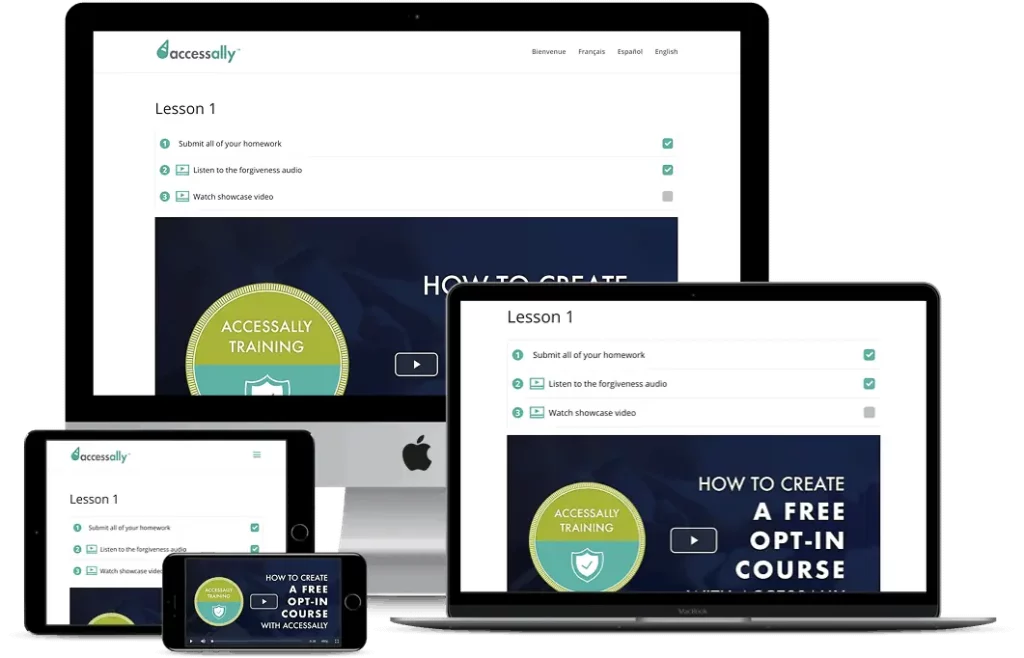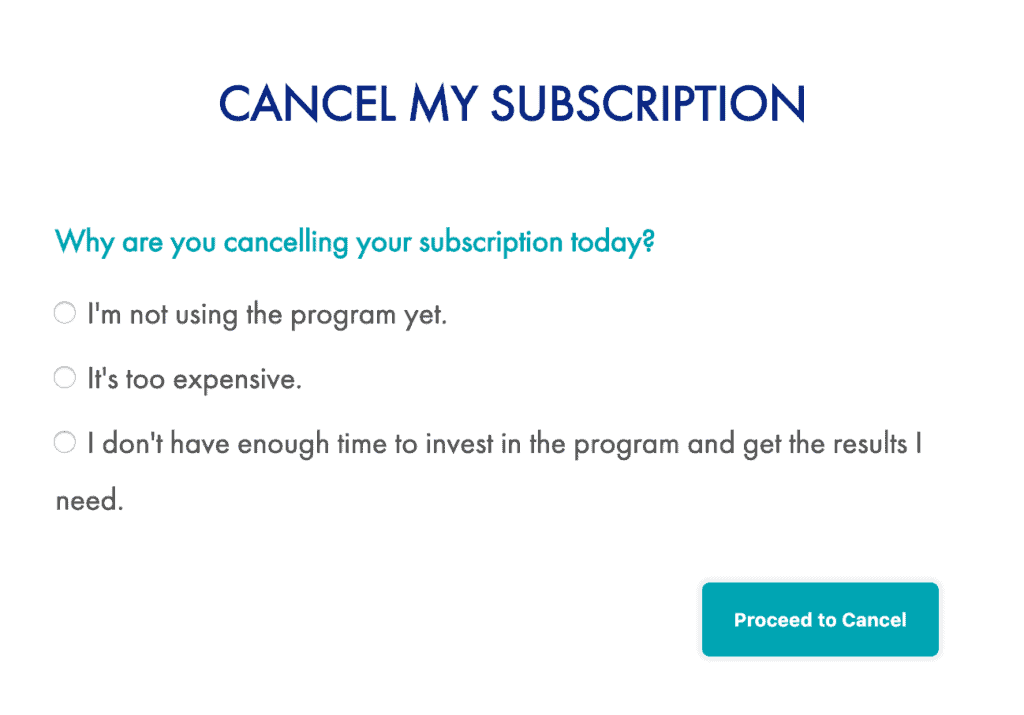You’ve heard it all before: online courses are the best digital products. No wait, membership sites are the way to go for recurring revenue!
But, in the online courses vs. membership site debate, which of the two is really the best one for your course?
Unless you’ve created and sold a variety of online courses and membership site programs, it’s hard to separate the theory from reality.
When making the decision between online courses vs. membership sites it depends on so many factors like your industry, your experience, your goals, and your bandwidth for creating content.
And in truth, neither is better — but one might be better for your business’ goals, resources, and vision.
This post will help you drill down into each of these areas and decide whether online courses or a membership site is the right digital product for your business.
What’s the difference between Online Courses and Membership Sites?
Online courses and membership sites are different, and it’s important to understand the differences to help you make your decision on which is better for your business.
An online course is typically a linear educational experience. It’s usually a one-time engagement for a student who will proceed through various course content including video or text lessons, printable or digital worksheets, quizzes or assignments, and so on. A course may also include a community component, coaching or Q&A sessions, and even some sort of certification at the end.
A membership site, on the other hand, is a more open-ended engagement for a student. They may be able to choose from a variety of resources within the membership — which might include online courses, ebooks, webinars, coaching or Q&A calls, videos and more. The membership site might also include a community where members can interact with one another.
The biggest difference between online courses vs. membership sites is that an online course is typically a one-and-done purchase; even if there is a payment plan involved, students only pay for the course once. They may or may not be able to go through the course materials more than once.
A membership site, on the other hand, might have a one-time payment, or more often it involves a subscription-style fee to access the materials. Students pay for access to the resources and their access is revoked when they end their membership.
Prefer to watch instead of read? We’ve created a video for you with the most important points on how to choose between online courses vs. membership sites.
The Pros and Cons of Online Courses
- You only have to create online course content once.
- You can charge the full amount for the value provided in an online course upfront.
- You can get your students results faster with an online course.
- You control the schedule of an online course.
- You only get paid once for an online course.
- You have to continue finding new clients to sell your online course to.
Pros of Online Courses
You only have to create online course content once.


With an online course, you’re not on the hook to continue adding new content over time like you would with a membership model.
However, you’re probably not going to leave the content as is forever. Over time you will probably come back and update it as your knowledge and expertise evolve and you gather feedback from your students.
So, while it’s not completely a one-and-done process, it’s definitely not as labor-intensive in terms of content creation that a recurring membership model requires.
You can charge the full amount for the value provided in an online course upfront.
People are used to paying right away for the things they’re purchasing. Selling online courses allows you to have a great amount of cash flow coming in at the start of your course.
You can even offer payment plans that will disburse your income over time, to a certain extent. You can easily create payment plans using a learning management system or membership plugin like AccessAlly to sell your online courses and memberships.
Having a payment plan option is a great way to increase your conversions, but overall you’ll have a good chunk of people paying in full because there’s usually a price break.
You can get your students results faster with an online course.


Online courses tend to have a set or recommended timeframe for completion. This makes it easier for you to get your students the results they are looking for from your material a little bit faster than you could with a membership model.
The faster you help people get results, the more they’re going to love your content. And the more they’re going to tell their friends how amazing and successful they were with your course.
Word-of-mouth marketing is some of the best free advertising you can get for your course.
You control the schedule of an online course.
Another benefit of online courses is that you can decide when you want to run your course live and open or close enrollment.
You have full control over your schedule year-round when you sell live courses online.
And if you need to take time off because it’s summertime and your kids are out of school, or because it’s the holiday season, it is totally in your control when you are in sales mode and have to create your course materials.
The Cons of Selling an Online Course
So what are the downsides of online courses?
You only get paid once for an online course.
When selling access to a course your customers buy from you once and may never give you any other money ever again. You may be able to combat this by having multiple online course offerings that you can sell over time.
Additionally, there’s the feast and famine cycle that course creators, sometimes, know all too well.
You might have a great month. Your bank account fills up, and you’re excited. And then a couple of months later, it’s dwindled back down because you haven’t launched your online course again.
You have to continue finding new clients to sell your online course to.
If you’re constantly marketing, creating free content, and putting in the effort to reach a wider audience, you’re not affording yourself the opportunity to rest while you’re building your business.
The majority of your efforts will be focused on advertising and marketing, speaking at live events or on podcasts, and other outreach opportunities to grow your audience and get people in the door so you can sell courses from your website and third-party platforms.
When you rest, your business suffers because you’re not marketing and building your audience of new prospective customers.
Once you have a few launches under your belt, this gets easier over time, but just starting out it can be draining.
The Pros and Cons of Membership Sites
- Predictable cash flow from recurring revenue with a membership site.
- You’re not creating content in a vacuum with a membership.
- Membership sites build long-term relationships with customers.
- You don’t have to do everything yourself with a membership.
- Membership sites can create a content creation hamster wheel.
- Audience size matters when it comes to running a membership site.
- Cancellations and churn are higher for membership sites vs. online courses.
Switching gears, let’s dive into the benefits of membership sites compared to online courses.
Predictable cash flow from recurring revenue with a membership site.


Recurring revenue is the most raved-about benefit of running a membership site.
Getting paid every single month makes it possible for you to forecast the amount you’ll earn month to month based on the amount you charge each month and the number of members you have.
You’ll want to be sure that you’re accounting for the percentage of your members that will churn month to month but this projection gives you a good idea of what you can expect your revenue to be.
Knowing your monthly projections makes it possible for you to plan ahead financially, and make decisions about advertising investments, hiring, amongst other expenses in your business.
Having this peace of mind is invaluable.
You’re not creating content in a vacuum with a membership.
When you create a membership site that includes new content releases each month, you won’t be the only person coming up with the ideas for new content.
Your existing members will naturally share with you exactly what they want to get from their membership, what they want more of, and what they want less of.
With the right LMS, you can even have an area where your members can communicate with you using private notes for them to provide feedback and share ideas.
The membership community you create will help guide your content creation efforts and you’ll feel confident knowing what you’re creating is exactly what they need to be successful and reach their goals.
Membership sites build long-term relationships with customers.
Having a membership site vs. an online course creates a different dynamic between you and your customers.
Membership sites tend to retain customers for the long term compared to online courses that tend to be short-term. The long-term membership makes it possible for the membership site owner to build relationships and get to know your members better.
If you have a forum or another community set up where people can ask questions or join you for live coaching calls, you’re able to build in the types of touchpoints that allow you to get to know people and see their results and their evolution as they go through your materials over time.
You don’t have to do everything yourself with a membership.


Another huge benefit for membership sites and online courses, but especially memberships with a community is that you don’t have to do everything yourself.
Your members will start to support each other through the community you create. Whether that’s in a private Facebook group or a forum within your membership site, your members will support and engage with each other.
Your role is to be the coach and the leader of the community, but you don’t have to be the only one answering every single question that people have. Your members will start to build relationships with other members and at times buddy up and become accountability partners.
They will keep each other going, motivate each other and answer each other’s questions. Especially as you have older members who become really familiar with your material and newer members who join. Your older members will naturally become mentors to your new members.
The Cons of Selling Membership Site Access
In a lot of instances the benefits of membership sites will outweigh the cons, but let’s take a look at a few things you should consider before committing to a membership model for your business.
Membership sites can create a content creation hamster wheel.
The amount of time required to create content can be a turnoff for some people. If this is the case for you, creating an online course is likely a better fit than creating a membership site.
When you commit to creating a membership site, it’s inevitable that you will spend a great deal of time and effort creating content.
You’ll also find that you need to be available on a regular basis to your membership community.
However, there are a lot of different ways to structure your membership site that makes the content creation and your availability manageable.
Batching your content creation is one great way to prevent overwhelm and limiting the number of live calls you promise is also a great way to manage your membership community’s expectations in terms of access to you.
Everything you need to know about creating a membership site can be found here.
Audience size matters when it comes to running a membership site.
The other big downside of running a membership site is that unless you have a very large audience, you’re probably not going to make as much money at the very beginning.
Memberships tend to have a lower price point than online courses. This requires you to have a lot more members to make the same amount you would if you were only offering a higher-priced online course.
When you first launch your membership, it can feel like you’re doing the same amount of work, but not getting paid as much, so keep this in mind as you evaluate the pros and cons of online courses vs. membership sites.
If your audience is large enough, you’ll be able to enroll members at a lower price point and create a thriving membership community with great recurring income.
However, if you’re new to online business or have done one-on-one work in the past and don’t have a large audience, membership business models may not be the right fit for you at this time.
Cancellations and churn are higher for membership sites vs. online courses.
The last membership site con is that cancellations happen.
It’s inevitable when you run a membership site. It’s just part of the business and is totally normal. People sign up for a membership, and then things change in their lives that result in them canceling.
There are many strategies you can use to reduce churn amongst your members – including gathering feedback and win-back campaigns, so be open to trying new things and pivoting your setup to best support your members.


Mistakes to Avoid When Starting an Online Course vs. Membership Site
One of the biggest mistakes I see people make when starting out with an online course is they get it launched and they’ve got a handful of people going through their course, but then they hear about membership sites.
They get excited about the idea of adding recurring revenue to their business.
Because let’s be honest – when it comes to online courses, there are ups and downs during the launch window and it’s either feast or famine when it comes to sales. When you’re in launch mode, the cash is rolling in, but once you close enrollment, famine sets in.
Now, that doesn’t mean your business has to suffer, you just have to budget accordingly. However, recurring revenue can be extremely enticing during those famine months.
Enter the membership site model.
This is where the biggest mistakes are made. Many entrepreneurs will take their online course and turn it into a membership model, and that’s not always the best route to take.
Here’s why:
If you’re selling your online course for $500, but change it to a membership model where you charge $50/month, you would need to keep each customer for a minimum of 10 months to make the same amount of money.
With a membership site vs. online course, you may have more members signing up at the lower price point, but the likelihood of them staying long-term isn’t as high, resulting in a lower customer lifetime value for each person who buys. Get more insights on how to price your membership site.
For a membership site to work, you need to consistently add new members on a regular basis to make up for the lost income you would get at your original price point for an online course.
There is a tweak you could make to this model to make it more profitable. Instead of turning your online course into a recurring monthly membership, you could keep the price the same and turn it into a yearly membership.
Your yearly membership becomes your recurring revenue; some of your members will stay on year after year at that same price and you get the best of both worlds.
You’ll have the same amount of upfront income from the yearly membership as you would your course so you can reinvest some of that income back into your business to scale your offering.
You can even keep enrollment open as an evergreen model year-round allowing every month to be an opportunity for revenue.
It’s Time to Decide: Will it be a Membership Site or Online Course?
Now that you’ve heard the pros and cons of membership sites vs. online courses it’s time to decide which model is best for your business.
Let’s take a look at a couple of different factors, so you can decide what’s going to be the best option for you.
The first thing to note, though, is that membership sites and online courses are not mutually exclusive.
You don’t have to have just an online course or just a membership site. In fact, having both types of offerings tends to be a great way to build a business that’s scalable and a little bit more steady and predictable.
The best part about this strategy is that your customers might move from one to the other. This is a great way to build upsells and cross-selling into your business.
Just remember, whatever business models you start with today can evolve and change over time.
- Your bandwidth is limited when it comes to the time and effort you have available for creating new content.
- You want to have a lot of flexibility in your schedule for busy seasons and downtime.
- You have a higher-priced offering and prefer to get paid in full upfront.
- You’re committed to getting your students results as quickly as possible.
- You prefer to have that long-term relationship with your customers and clients.
- The amount of ongoing content you need to create excites you.
- You want to create an online community of like-minded individuals who can support one another.
- You want a predictable cash flow from your monthly or yearly memberships.
Online Courses Might Be Right For You If…
Your topic and your expertise really lend themselves to teaching people in a dedicated timeframe. This allows you to focus on getting your students results, gather testimonials, establish credibility for your offerings, and get a lot more income straight up ahead.
Choose an online courses business model if:
- Your bandwidth is limited when it comes to the time and effort you have available for creating new content.
- You want to have a lot of flexibility in your schedule for busy seasons and downtime.
- You have a higher-priced offering and prefer to get paid in full upfront.
- You’re committed to getting your students results as quickly as possible.
Online courses are also a great fit if you’re just getting started online because online businesses need a good cash flow, especially in the beginning.
You’ll be able to gather feedback quickly and wrap up your first launch so you can reinvest in your business and use your online course as a way to test your content.
A Membership Site Might Be Right For You If…
Your topic really lends itself to the mastery and practice of a skill. If your offer requires a long-term time investment to improve a member’s skills like playing the guitar or learning a new language, for example, these are the kinds of training that easily lend themselves to a membership site.
A membership site business could be a better option if:
- You prefer to have that long-term relationship with your customers and clients.
- The amount of ongoing content you need to create excites you.
- You want to create an online community of like-minded individuals who can support one another.
- You want a predictable cash flow from your monthly or yearly memberships.
Also, consider how many people you have in your community and what price point you will offer your membership.
If you really want to launch a membership site, but are realizing that the size of your community, your email list, and your social media accounts are a bit of a limiting factor for scaling head over to 30DayListBuildingChallenge.com and sign up for this free challenge.


You’ll get insights and tips on how to build your email list faster in the next 30 days than you have in the last three months. This training will help you get going faster and also help you get ready to launch your course or your membership.
Technology that Supports Your Course and Membership Goals
Whether you decide to build an online course or a membership site, investing in technology that is built to scale and support your vision is fundamental to your success.
We have a robust archive of the best LMS plugins and platforms to help guide you.
Our membership management and LMS Plugin, AccessAlly, was designed to support both membership site owners and online course creators. Find out if it’s right for you with a free demo.





